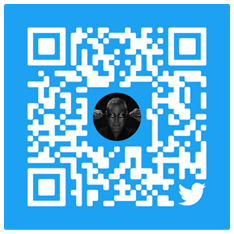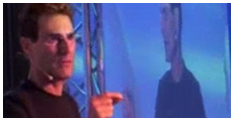Article on Uri Geller’s Powers in Science Digest – April 1976
Science Digest, April 1976
URI GELLER’S POWERS ARE GENUINE!
By John Taylor
 |
An eminent scientist subjects Uri Geller, the Israeli practitioner of psychokinesis, to a series of experiments that tests his powers of “mind over matter.” Here are the results of those experiments.
ON THE EVENING of Friday, 23 November 1973, British television viewers were surprised and baffled by the incredible sight of a fork collapsing under the influence of Uri Geller, an entertainer from Israel. Not only did he cause the fork to break after a minute’s gentle stroking, but he was able, without touching it, to cause the bending of another one lying nearby on the table. He followed this up by restarting a stopped watch, bending the second hand inside the watchglass, and capped his performance by correctly guessing the details of a drawing scaled in two envelopes.
As the transmission (a Dimbleby Talk-In programme) ended, uproar broke out among the specially selected audience. People surged forward to scrutinize the bent or broken cutlery and ticking watch and to compare Geller’s sketch with the original drawing. Some skeptics protested that it was all a fraud: one, a professional magician, claimed that given time he could perform all these “tricks”.
Geller’s demonstration of his amazing powers produced other effects which were even more incredible than those he had achieved himself. For it turned out that in hundreds of homes throughout Great Britain, cutlery had been bent and timepieces, long defunct, restarted. Several hundred people telephoned Science Digest, the BBC, to describe their experiences; many others wrote in. The extraordinarily vociferous response has persisted ever since, and has usually been polarised to the extremes of the charge of outright fraud, and of total disbelief.
The power of telepathy and clairvoyance (the ability to perceive distant or otherwise hidden objects directly) are not recent discoveries, though. Only since the latter part of the last century have they been intensively investigated. The distinctly new element which Geller has contributed to the ESP debate has to do with psychokinesis, the power of mind over matter. Not that this is new, but his particular form of it is. This was dramatically brought to the public’s attention during the Dimbleby Talk-In when his gentle stroking of one end of a fork resulted in its breaking within a minute or so. Dimbleby, who was loosely holding the other end, was heard to exclaim: “It’s bending It’s cracking! I can feel it cracking! It’s breaking.”
I could see the fork all the time Geller was touching it; he did not appear to be exerting any pressure or force, certainly not enough to break it. A startling feature of the demonstration was that the end of the fork just fell off as if the neck had become plastic a moment before. The fork which was broken had been taken from a selection on a tray put in front of the participants. A few minutes later it was noticed that another of these forks had bent at right angles at its neck.
It is as a metal-bender that Uri Geller subsequently became known in England. The variety of metal objects he had bent-keys, knives, forks, spoons, nails, iron rods, scissors and so on – is astounding.
No simple explanation of these occurrences of metal-bending is possible. Distracting the attention of the audience so that the bending can be achieved by force while they are all “looking the other way” hardly seems feasible, least of all in the many cases where keys and other objects were bent or broken without even being touched by Geller, or indeed by anyone else; nor does the substitution of already bent objects for the original ones, especially with highly personal things like keys.
The Experiments
 |
The features of the Geller phenomenon to investigate scientifically are the two physical ends-Geller’s brain and the inanimate object or the brain he is in contact with. Brain activity is notoriously difficult to monitor. lt is very complex and the crucial variables describing its activity are not known. What is more, workers at the Stanford Research Institute had difficulty with Geller in that he did not relish having electrodes attached to his scalp to monitor his brain waves. [The Institute conducted extensive experiments to test Geller’s powers in late 1972 and again in August 1973]. Even with complete cooperation on Geller’s part, the fact is that the brain still presents an enormous puzzle to science. We are therefore left with the other end the object on which Geller and others like him act. It makes sense to confine our investigations to what might be called “the Geller effect” – that of metal-bending pure and simple..
 |
The scientific tests which Geller was subjected to at Stanford did not probe deeply into metal-bending, owing to the possibility that he might have been causing it by physical pressure. To avoid any likelihood of this, it is necessary to do one of two things. On the one hand, tests must be carried out in which such force as is applied during the bending is measured while the experiment is in progress. If less force were used by Geller during a bending session than would be needed to cause the metal to bend by the amount it actually had, then some unknown, non mechanical force would have been responsible and the Geller effect authenticated. This approach is at present under way, but requires delicate measuring devices embedded in pieces of metal to register the amount of force actually applied.
A more direct test, which precludes the question of the mechanical force applied during bending, is to require that metal be bent without Geller actually touching it. If he can achieve that, then the Geller effect is indeed beyond current scientific understanding. Geller did not achieve any well authenticated bending at a distance during his time at Stanford, but on 2 February 1974, during one of his visits to England, a successful test of this kind was carried out with Geller by myself. Pieces of metal (aluminium and copper), strips of various types of plastic, some single crystals of potassium bromide which were long enough to be stroked like pieces of cutlery, various wire mesh tubes and a sealed glass tube containing a strip of aluminium – all these were used to try out Geller’s powers. In addition, a small but sensitive Geiger counter – to detect radioactivity – and a primitive detector of ultraviolet radiation were included in the apparatus.
The various strips of metal and plastic and the scaled glass tube were laid a few inches apart on a metal sheet. A strip of aluminium, placed inside a wire mesh tube with its end firmly fixed, was also laid out. The objects had been prepared in the metallurgical department of King’s College, London, and there was no chance of Geller having been in con tact with them before the experiment. Two of my colleagues were also in the room observing Geller.
The various strips of metal and plastic were carefully scrutinized at the beginning of the test to confirm that they were straight. First of all, Geller tried to bend a metal rod without touching it, but he did not succeed. It was then observed that one of the aluminium strips lying on the tray was now bent, without, as far as could be seen, having been touched either by Geller or by anyone else in the room.
To see whether Geller could repeat the metal-bending feat of the Dimbleby programme, he was then handed a teaspoon which had been brought along with the other materials. I held the bowl end while Geller stroked it gently with one hand. After about 20 seconds the thinnest part of the stem suddenly became soft for a length of approximately half a centimetre and then the spoon broke in two. The ends very rapidly hardened up again – in less than a second. There was also, as far as could be determined by touch, a complete absence of heat, at the fracture. This sequence of sudden softening and complete loss of cohesive strength, breakage, and then rapid hardening was almost identical to that observed when the fork broke during the Dimbleby programme. Here, under laboratory conditions we had been able to repeat this remarkable experiment. Geller could simply not have surreptitiously applied enough pressure to have brought this about, not to mention the pre-breakage softening, of the metal. Nor could, the teaspoon have been tampered with – it had been in my possession for the past year.
Then Geller gently stroked a single crystal of potassium bromide about two centimetres long, and, it split into two pieces within ten seconds. It was difficult to assess the force that had actually been applied to the crystal, but subsequent tests have shown that such crystals cannot be broken by gentle stroking alone. To show, of course, that pressure was not the cause of the crystals breaking and that this was a paranormal effect, it would be necessary to measure how much pressure Geller had in fact applied. Geller also stroked a thin wooden strip with no result.
After this series of tests the objects on the tray were re-examined. It was found that the last five centimetres at one end of the aluminium strip in the closed wire mesh tube was now bent with a radius of curvature of about five centimetres.
At this point the primitive ultra- violet detector was used. This was constructed of a strip of annealed aluminium, covered with a thin layer of sodium salicylate, and scaled in a partial vacuum within a quartz glass tube. In darkness the salicylate layer glows purple in response to ultraviolet radiation. This can also be produced by rubbing the tube so as to generate a high static electrical potential on its surface by means of friction; electron emission will then produce ultraviolet radiation. Geller attempted to bend the metal inside the quartz tube, first of all without touching it and finally, when that failed, by stroking it gently. The purple fluorescence he produced was no greater than what might have been expected from the, static electricity generated by friction. As the metal strip in this tube did not bend, the result, although it did not give any support for ultraviolet radiation as the agent causing bending, equally could still not allow us to rule it out.
The final test was to determine if Geller could produce a deflection on the Geiger counter; this should indicate whether he could produce radioactive radiation. When it was held near him, Geller registered a zero count on the instrument, taking into account the average background rate of about two counts per second produced by cosmic rays coming from outer space. Geller then took the monitor in his own hands and tried to influence the counting rate. We all stood round looking at the dial and listening for the telltale tone.
At first nothing happened, but by extreme concentration and an increase in muscular tension associated with a rising pulse rate, the needle deflected to 50 counts per second for a full two seconds, the sound effects heightening the drama of the occasion. By means of a small loudspeaker each count produced a “pip,” and before Geller affected the machine the sound was of a steady “pip … pip … pip . . . .” In his hands the sound sud- denly rose to become a wail, one which usually indicates dangerous radioactive material nearby. When Geller stopped concentrating the Wail stopped and the apparent danger with it. This wail was repeated twice more, and then when a deflection of 1 00 counts per second was achieved, the wail rose almost to a scream. Between each of these attempts there was an interval of about a minute. A final attempt made the needle deflect to a reading of 1000 counts per second, again lasting for about two seconds. This was 500 times the background rate – the machine was emitting a scream in the process. After a rest of several minutes, a further deflection of 200 counts per second was produced, lasting about five seconds.
At the end of the session the Geiger counter was tested to see if its counting rate could be modified by pressure on the monitor to produce the same effect. Despite the considerable force applied, no change came in the counting rate ftom that caused by background radiation. It therefore seemed unlikely that Geller had achieved this effect by distortion of the monitor.
The conclusions of these experiments were threefold. First of all there was clear authentication of the metal-bending effect, both by the distortion of the aluminium strip in the closed wire mesh tube and by the rapid breaking of the teaspoon. Secondly, that metal could be bent inside the mesh enclosure indicated that if electromagnetic radiation were causing the effect at all, then only a restricted range of wavelength could have been responsible.
The third conclusion to be drawn from the experiment was that a wide range of effects can occur, including causing a Geiger counter reading to be considerably modified.
Ed Mitchell, the ex-astronaut,who sponsored the Geller experiments at the Stanford Research Instittite, found that the pocket computer he was carrying sometimes failed to function in Geller’s presence. It has even been said that Geller can disturb any scientific instrument if he so wishes. He certainly could modify a Geiger counter, and he also affected a Schmidt generator, a machine which is controlled by radioactive decay.
This instrument has nine bulbs arranged around the. circumference of a circle, and the light moves either clockwise or anticlockwise atlrandom from the lit bulb to the next one, as determined by the radioactive decay. According to Dr. Ted Bastin, who performed this test on Geller in February 1974, Geller was able to cause the movement of the light to proceed according to his own dictates.
Uri Geller appears to have posed a serious challenge for modern scientists. Either a satisfactory explanation must be given for his phenomenon within the framework of accepted scientific knowledge, or science will be found seriously wanting. Since such an explanation appears to some to be impossible, either now or in the fu- ture, they argue that the Geller phe- nomenon is incompatible with scientific truth, and that the value of reason and the scientific point of view is therefore an illusion. Will the gates of unreason then be allowed to open and drown us in a world inhabited by aetheric bodies, extra-terrestrial visitors, spirits of the dead and the like?
These were the anxieties aroused in me as a scientist as I sat in the studio beside Uri Geller during the BBC telecast. Here was I, a trained physicist, a researcher for the past 20 years into the mysteries of matter and mind, witnessing something which I knew I could not explain to myself – let alone to those millions of viewers. My previous areas of research have included elementary particles, the basic constituents of matter, black holes, those “heavy stars” which have collapsed in on themselves and appear black because they totally absorb any light shone on them, the forces of nature and, more recently, certain aspects of brain function. And here, with Geller, we could be seeing a demonstration that would, as I saw it, confound our fundamental ideas about both the latter.
Part of the job of looking at the world through the eyes of a trained scientist is to look for ways of improving our current scientific models of the world by testing them under the severest conditions. Our theories of gravity are tested to their utmost by events at the centre of a black hole where the force of gravity becomes iinfinite; ideas about the microstructure of matter receive the ultimate test by the scattering of elementary particles away from each other at the highest available energies. The questions raised by the Geller phenomenon appear to be of a similar, perhaps of an even more difficult nature. Because of this, there could be much to gain from a scientific explanation of the powers of Uri Geller. Above all, scientists should not shirk this challenge to the way they view the world.
Ways must therefore be found of applying the scientific method to discovering the cause of the phenomenon.


Latest Articles

Motivational Inspirational Speaker
Motivational, inspirational, empowering compelling 'infotainment' which leaves the audience amazed, mesmerized, motivated, enthusiastic, revitalised and with a much improved positive mental attitude, state of mind & self-belief.



















